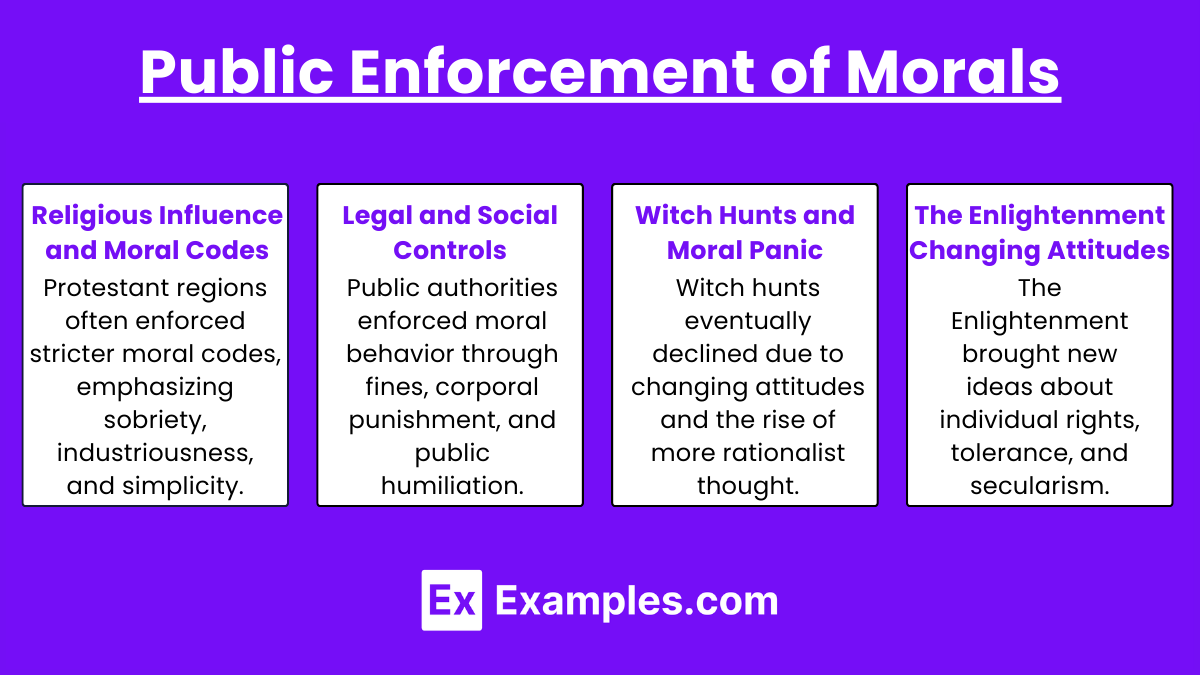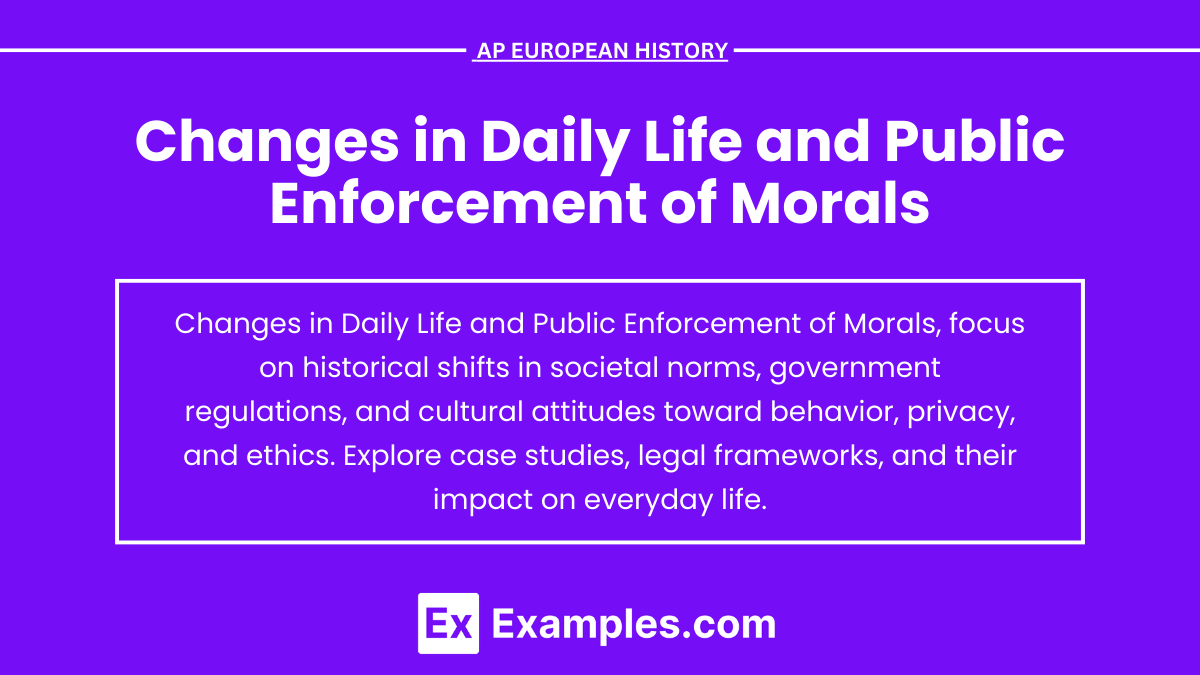During the 16th to 18th centuries, Europe underwent meaningful changes in daily life and public enforcement of morals. Urbanization and population growth reshaped social dynamics, while new economic opportunities altered work and family structures. Religious reforms, such as the Reformation and Counter-Reformation, significantly influenced moral expectations. Public authorities enforced these moral codes through laws, fines, and punishments. These transformations reflected the broader cultural and societal shifts of the time, laying the foundations for modern European society and its evolving moral landscape.
Learning Objectives
In preparing for the AP European History exam, focus on the significant changes in daily life in Europe from 1500 to 1800. Understand how urbanization, family dynamics, and work practices evolved during this period. Study the influence of religious movements, such as the Reformation, on public morals and the enforcement methods, including sumptuary laws and witch hunts. Examine the impact of the Enlightenment in shifting towards secular and humane governance, highlighting the broader social and cultural shifts that shaped early modern Europe.
Changes in Daily Life

1. Urbanization and Population Growth
- The population of Europe grew significantly from the late 15th century onwards.
- This growth, coupled with urbanization, led to crowded cities and changes in living conditions.
- Urban centers became hubs of commerce and culture but also faced challenges like poverty and crime.
2. Family and Social Structures
- The traditional family structure, centered around extended families, began to shift towards nuclear families.
- Marriage ages varied, but economic conditions often influenced when and whom people married.
- Social mobility increased slightly, though class distinctions remained pronounced.
3. Work and Leisure
- The agricultural economy began to transition with the growth of commerce and industry.
- Guilds played a crucial role in regulating trades and crafts.
- Leisure activities included fairs, festivals, and public executions, which were popular forms of entertainment.
4. Diet and Health
- Diets improved with the introduction of new foods from the Americas, like potatoes and tomatoes.
- However, the poor still faced malnutrition and disease.
- Advances in medical knowledge were slow, and public health measures were rudimentary.
Public Enforcement of Morals

1. Religious Influence and Moral Codes
- The Reformation and Counter-Reformation profoundly influenced moral attitudes.
- Protestant regions often enforced stricter moral codes, emphasizing sobriety, industriousness, and simplicity.
- Catholic areas, influenced by the Council of Trent, reinforced traditional moral teachings and practices.
2. Legal and Social Controls
- Sumptuary laws regulated clothing and consumption, aiming to maintain social hierarchies and prevent extravagance.
- Public authorities enforced moral behavior through fines, corporal punishment, and public humiliation.
- Crimes like adultery, blasphemy, and drunkenness were often punished harshly to uphold societal norms.
3. Witch Hunts and Moral Panic
- The 16th and 17th centuries saw widespread witch hunts, reflecting fears of social disorder and heresy.
- These persecutions were often driven by local conflicts, economic stress, and religious zeal.
- Witch hunts eventually declined due to changing attitudes and the rise of more rationalist thought.
4. The Enlightenment and Changing Attitudes
- The Enlightenment brought new ideas about individual rights, tolerance, and secularism.
- Philosophers like Voltaire and Rousseau challenged traditional authorities and promoted personal freedom.
- This period saw a gradual shift towards more humane and secular approaches to governance and social control.
The period from 1500 to 1800 was one of profound change in Europe. Daily life evolved with urbanization and economic transformation, while public enforcement of morals reflected the complex interplay of religion, law, and social norms. These changes laid the groundwork for modern European society, influencing everything from family life to the role of the state in regulating behavior.
Examples of Changes in Daily Life and Public Enforcement of Morals (1500-1800)
- Urbanization and Public Health
- Growing cities faced sanitation issues, leading to public health measures like street cleaning and waste regulation.
- Sumptuary Laws
- These laws restricted extravagant clothing and luxury items to maintain social order and prevent excessive display of wealth.
- Witch Hunts
- Witch hunts, particularly in the 16th and 17th centuries, targeted those accused of witchcraft, reflecting societal fears and moral panic.
- Religious Influence on Morality
- The Reformation led to stricter moral codes in Protestant regions, emphasizing sobriety and industriousness.
- Public Punishments
- Public executions and punishments for crimes like adultery and blasphemy served as deterrents and reinforced societal norms.
Practice Questions on Changes in Daily Life and Public Enforcement of Morals
Question 1:
Which of the following best describes a key feature of urbanization in Europe between 1500 and 1800? A) Decline in trade and commerce
B) Improved public sanitation and health
C) Increased population density and overcrowding
D) Reduced social and economic disparities
Answer: C) Increased population density and overcrowding
Explanation: As European cities grew during this period, they often became overcrowded, leading to various social and public health challenges.
Question 2:
Sumptuary laws in early modern Europe were primarily intended to: A) Encourage religious diversity
B) Limit the consumption of alcohol
C) Regulate the dress and behavior of different social classes
D) Promote the agricultural economy
Answer: C) Regulate the dress and behavior of different social classes
Explanation: Sumptuary laws were enacted to maintain social hierarchies by restricting certain clothing and luxury items to specific classes, preventing people from dressing above their status.
Question 3:
The widespread witch hunts in Europe during the 16th and 17th centuries were largely a result of: A) Scientific advancements in medicine
B) Increased literacy and education
C) Economic competition and local conflicts
D) The Enlightenment’s focus on reason and skepticism
Answer: C) Economic competition and local conflicts
Explanation: Witch hunts often arose from local conflicts, economic stress, and societal fears, as communities sought to find scapegoats for misfortunes and maintain social order.


